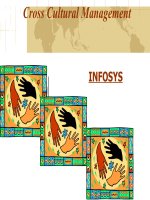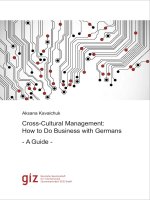Cross cultural management 3e by cullen ch09
Bạn đang xem bản rút gọn của tài liệu. Xem và tải ngay bản đầy đủ của tài liệu tại đây (799.54 KB, 50 trang )
Chapter 9
Multinational E-Commerce:
Strategies and Structures
Copyright© 2004 Thomson Learning All rights reserved
Learning Objectives
••
••
••
••
Define
Define the
the forms
forms ofof e-commerce
e-commerce
Appreciate
Appreciate the
the growing
growing presence
presence ofof e-commerce
e-commerce inin the
the
global
global economy
economy
Understand
Understand the
the structure
structure ofof the
the Internet
Internet economy
economy
Identify
Identify the
the basic
basic components
components ofof successful
successful
e-commerce
e-commerce strategy
strategy
Copyright© 2005 South-Western/Thomson Learning All rights reserved
Learning Objectives
•• Understand
Understand the
the attractions
attractions ofof and
and deterrents
deterrents toto building
building
aa multinational
multinational e-commerce
e-commerce business
business
•• Know
Know the
the basic
basic multinational
multinational e-commerce
e-commerce business
business
models
models
•• Identify
Identify the
the practicalities
practicalities ofof running
running aa multinational
multinational
e-commerce
e-commerce business
business
•• Understand
Understand the
the function
function ofof enablers
enablers inin multinational
multinational
e-commerce
e-commerce operations
operations
Copyright© 2005 South-Western/Thomson Learning All rights reserved
The Internet Economy
•• Internet
Internet Economy
Economy
•• Growing
Growing faster
faster than
than any
any other
other business
business trend
trend inin
history
history
•• Companies
Companies face
face issues
issues similar
similar toto those
those faced
faced by
by
traditional
traditional multinational
multinational companies
companies
Copyright© 2005 South-Western/Thomson Learning All rights reserved
What Is E-Commerce?
•• Refers
Refers toto the
the selling
selling ofof goods
goods or
or services
services over
over the
the
Internet
Internet
•• Includes
Includes goods
goods or
or services
services delivered
delivered offline
offline
•• E.g.,
E.g.,Amazon.com
Amazon.com shipping
shipping book
book via
via UPS
UPS
•• Also
Also includes
includes goods
goods and
and services
services delivered
delivered online
online
•• E.g.,
E.g., downloaded
downloaded computer
computer software
software
Copyright© 2005 South-Western/Thomson Learning All rights reserved
Types of E-Commerce
Transactions
•• B2C:
B2C: business-to-consumer
business-to-consumer transactions
transactions
•• Buying
Buying toys
toys from
from eToys
eToys
•• B2B:
B2B: business-to-business
business-to-business transactions
transactions
•• Makes
Makes up
up 70
70 toto 85%
85% ofof current
current e-commerce
e-commerce
business
business
•• C2C:
C2C: consumer-to
consumer-to consumer
consumer transactions
transactions
•• Anyone
Anyone selling
selling online
online
•• C2B:
C2B: consumer-to-business
consumer-to-business transactions
transactions
Copyright© 2005 South-Western/Thomson Learning All rights reserved
Exhibit 9.1: E-Commerce
Value Chain
Copyright© 2005 South-Western/Thomson Learning All rights reserved
The Internet Economy
•• Two
Two indicators
indicators ofof the
the global
global presence
presence ofof e-commerce
e-commerce
•• Secure
Secure server:
server: an
an Internet
Internet host
host that
that allows
allows users
users toto
send
send and
and receive
receive encrypted
encrypted data
data
•• Internet
Internet hosts:
hosts: computers
computers connected
connected toto the
the Internet
Internet
with
with their
their own
own IP
IPaddresses
addresses
•• OECD
OECD dominate
dominate the
the Internet
Internet with
with over
over 90%
90% ofof Internet
Internet
hosts
hosts
Copyright© 2005 South-Western/Thomson Learning All rights reserved
Exhibit 9.2: Secure Servers
and Internet Hosts in Selected
OECD Countries
Copyright© 2005 South-Western/Thomson Learning All rights reserved
The Internet Economy
•• InIn 1991,
1991, 33 million
million people
people used
used the
the Internet
Internet and
and almost
almost
none
none used
used itit for
for e-commerce.
e-commerce.
•• Between
Between 2001
2001 and
and 2002,
2002, U.S.
U.S. consumers
consumers spent
spent over
over
$1.3
$1.3 billion
billion on
on e-commerce,
e-commerce, increase
increase ofof over
over 90%.
90%.
•• Recent
Recent estimates
estimates suggest
suggest growth
growth around
around the
the world.
world.
•• Offers
Offers tremendous
tremendous opportunities
opportunities for
for multinationals
multinationals
Copyright© 2005 South-Western/Thomson Learning All rights reserved
Exhibit 9.3: Internet Users
around the World
Copyright© 2005 South-Western/Thomson Learning All rights reserved
The Internet Economy
•• Internet
Internet economy
economy has
has four
four layers
layers
•• The
The infrastructure
infrastructure
•• The
The applications
applications infrastructure
infrastructure
•• The
The Internet
Internet intermediaries
intermediaries
•• The
The Internet
Internet commerce
commerce layer
layer
Copyright© 2005 South-Western/Thomson Learning All rights reserved
Layer 1
•• The
The Internet
Internet infrastructure
infrastructure isis the
the backbone
backbone ofof the
the
Internet,
Internet, including
including the
the Internet
Internet service
service providers,
providers, e.g.,
e.g.,
•• Communications
Communications (Qwest,
(Qwest, MCI/Worldcom)
MCI/Worldcom)
•• Internet
Internet service
service providers
providers (Mindspring,
(Mindspring,AOL,
AOL,
Earthlink)
Earthlink)
•• Networking
Networking (Cisco,
(Cisco, Lucent,
Lucent, 3Com)
3Com)
•• Hardware
Hardware (Dell,
(Dell, Compaq,
Compaq, HP)
HP)
Copyright© 2005 South-Western/Thomson Learning All rights reserved
Layer 2
•• The
The applications
applications infrastructure
infrastructure
•• Companies
Companies and
and consultants
consultants that
that build
build web
web systems
systems
and
and supporting
supporting software
software
•• Consultants
Consultants (SB1)
(SB1)
•• Commerce
Commerce applications
applications (Netscape,
(Netscape, Sun,
Sun, IBM)
IBM)
•• Web
Web development
development software
software (Adobe,
(Adobe, NetObjects)
NetObjects)
•• Search
Search engine
engine software
software (Verity)
(Verity)
•• Web-enable
Web-enable databases
databases (Oracle)
(Oracle)
Copyright© 2005 South-Western/Thomson Learning All rights reserved
Layer 3
•• The
The internet
internet intermediaries
intermediaries
•• Companies
Companies that
that provides
provides linking
linking services
services on
on the
the
Internet
Internet and
and derive
derive revenues
revenues from
from commissions,
commissions,
advertising,
advertising, and
and membership
membership fees
fees
•• Online
Online travel
travel agencies
agencies (Travelweb,
(Travelweb,
Travelocity.com)
Travelocity.com)
•• Online
Online brokerages
brokerages (E*TRADE)
(E*TRADE)
•• Content
Content aggregators
aggregators (CNET,
(CNET, ZDNet)
ZDNet)
•• Online
Online advertising
advertising (Yahoo!)
(Yahoo!)
Copyright© 2005 South-Western/Thomson Learning All rights reserved
Layer 4
•• The
The Internet
Internet commerce
commerce layer
layer
•• Companies
Companies that
that conduct
conduct commercial
commercial transactions
transactions on
on
the
the Web
Web
•• E-retailers
E-retailers (wine.com,
(wine.com, diamond.com)
diamond.com)
•• Manufacturers
Manufacturers selling
selling directly
directly (hpshopping.com,
(hpshopping.com,
Dell)
Dell)
•• Subscription-based
Subscription-based companies
companies (VRBO.com)
(VRBO.com)
•• Transportation
Transportation services
services (most
(most airlines)
airlines)
•• Shipping
Shipping services
services (FedEx,
(FedEx, UPS)
UPS)
Copyright© 2005 South-Western/Thomson Learning All rights reserved
Exhibit 9.4: Internet Businesses
Ranked on Business Week’s
Information Technology 100
Copyright© 2005 South-Western/Thomson Learning All rights reserved
Fundamentals of E-Commerce
••
••
••
E-commerce
E-commerce isis evolving
evolving quickly.
quickly.
Failures
Failures ofof many
many start-ups
start-ups show
show it’s
it’s not
not without
without risks.
risks.
E-commerce
E-commerce presents
presents significant
significant opportunities
opportunities and
and
threats.
threats.
Copyright© 2005 South-Western/Thomson Learning All rights reserved
Exhibit 9.5: Summary of
Threats and Opportunities
Copyright© 2005 South-Western/Thomson Learning All rights reserved
Five Steps for Successful
E-Commerce Strategy
1.1.Build
Build on
on current
current business
business models
models and
and experiment
experiment with
with
new
new e-commerce
e-commerce models
models
1.Use
1.Use e-commerce
e-commerce toto search
search for
for ways
ways toto reduce
reduce costs
costs
or
or enhance
enhance the
the business.
business.
2.2.Meet
Meet the
the challenge
challenge ofof developing
developing an
an e-commerce
e-commerce
organization
organization
1.Entire
1.Entire firm
firm (not
(not only
only top
top management)
management) must
must be
be
prepared
prepared toto embrace
embrace the
the e-commerce
e-commerce model.
model.
Copyright© 2005 South-Western/Thomson Learning All rights reserved
Steps for Successful
E-Commerce Strategy (cont.)
3.3.Allocate
Allocate resources
resources toto the
the e-commerce
e-commerce business
business
3.Commit
3.Commit financial,
financial, human,
human, and
and technological
technological
resources
resources toto develop
develop e-commerce
e-commerce capabilities
capabilities
4.4.Build
Build aa superior
superior e-commerce
e-commerce infrastructure
infrastructure as
as aa basis
basis
ofof aa differentiation
differentiation strategy
strategy
3.Provide
3.Provide superior
superior online
online experiences
experiences
Copyright© 2005 South-Western/Thomson Learning All rights reserved
Steps for Successful
E-Commerce Strategy (cont.)
•• Make
Make sure
sure the
the entire
entire management
management team
team aligns
aligns with
with the
the
e-commerce
e-commerce agenda
agenda
Copyright© 2005 South-Western/Thomson Learning All rights reserved
E-Commerce Structure:
Integrated or Autonomous
•• Company
Company needs
needs toto decide
decide how
how e-commerce
e-commerce fits
fits into
into
existing
existing design
design
•• Right
Right mixture
mixture ofof bricks
bricks and
and clicks
clicks
•• How
How much
much toto integrate
integrate Internet
Internet into
into traditional
traditional
businesses
businesses
•• Brick-and-mortar:
Brick-and-mortar: traditional
traditional or
or non-virtual
non-virtual business
business
operation
operation
Copyright© 2005 South-Western/Thomson Learning All rights reserved
Integrated or Autonomous
•• Degree
Degree ofof interaction
interaction between
between brick-and-mortar
brick-and-mortar
operations
operations can
can occur
occur anywhere
anywhere inin the
the value
value chain
chain
•• Can
Can range
range from
from near
near seamless
seamless operations
operations (e.g.,
(e.g., Office
Office
Depot)
Depot) toto the
the mostly
mostly independent
independent operations
operations (e.g.,
(e.g.,
Barnes
Barnes && Noble
Noble and
and Barnesandnoble.com)
Barnesandnoble.com)
Copyright© 2005 South-Western/Thomson Learning All rights reserved
E-Commerce Structure:
Integrated or Autonomous
•• The
The independent
independent benefits
benefits
•• Faster
Faster and
and more
more entrepreneurial
entrepreneurial
•• Freed
Freed from
from corporate
corporate bureaucracy
bureaucracy
•• The
The integrated
integrated benefits
benefits
•• Cross-promotion,
Cross-promotion, shared
shared information,
information, increased
increased
quantity
quantity purchases,
purchases, use
use ofof same
same distribution
distribution
channels
channels
Copyright© 2005 South-Western/Thomson Learning All rights reserved









